
Related
Guests
- Eleni SchirmerDebt Collective organizer, writer and postdoctoral fellow at Concordia University.
The Supreme Court heard oral arguments Tuesday in two challenges to the Biden administration’s student debt relief plan, which could give tens of millions of federal borrowers up to $20,000 of relief. During arguments, several conservative justices expressed skepticism over the Biden administration’s student debt relief plan, while liberal Justice Sonia Sotomayor blasted the Republican states who brought one of the lawsuits. We’re joined by Eleni Schirmer, who organizes with the Debt Collective and is a writer and postdoctoral fellow at Concordia University’s Social Justice Centre in Montreal. Her new piece in The New Yorker is headlined “How the Government Cancelled Betty Ann’s Debts.”
Transcript
AMY GOODMAN: This is Democracy Now!, democracynow.org, The War and Peace Report. I’m Amy Goodman, with Juan González.
The Supreme Court heard oral arguments Tuesday in two challenges to the Biden administration’s student debt relief plan, which could give tens of millions of federal borrowers up to $20,000 of relief each. Outside the court, activists rallied.
MADDY CLIFFORD: These lawsuits are bogus, literally backed by right-wing billionaires. Look it up. Rich people who have happily accepted government handouts in the form of having their PPP loans forgiven or receiving government subsidies — does the government work for them, or does it work for us? That’s my question. OK? So, if you ask me now what it feels like to be $120,000 in student loan debt, I say it feels like solidarity. It feels like power. If one person owes the bank, that’s that one person’s problem. But when a million people owe the bank, that’s the bank’s problem.
AMY GOODMAN: That’s Maddy Clifford of the Debt Collective. Supporters of student debt relief were joined by lawmakers including independent Senator Bernie Sanders, who called education a human right and said public colleges and universities should be tuition-free.
SEN. BERNIE SANDERS: In America, you should not have to face financial ruin because you want a damn education.
AMY GOODMAN: Inside the Supreme Court, several conservative justices expressed skepticism over the Biden student debt relief plan, while liberal Justice Sonia Sotomayor blasted the Republican states who brought one of the suits.
JUSTICE SONIA SOTOMAYOR: There’s 50 million students who are — will benefit from this, who today will struggle. Many of them don’t have assets sufficient to bail them out after the pandemic. They don’t have friends or families or others who can help them make these payments. The evidence is clear that many of them will have to default. Their financial situation will be even worse, because once you default, the hardship on you is exponentially greater. You can’t get credit. You’re going to pay higher prices for things. They are going to continue to suffer from this pandemic in a way that the general population doesn’t. And what you’re saying is now we’re going to give judges the right to decide how much aid to give them.
AMY GOODMAN: That’s Justice Sonia Sotomayor Tuesday. Before we’re joined by our next guest, I want to play a clip from a video produced by a More Perfect Union about a group funding the lawsuits against student debt relief called the Jobs Creators Network.
MADDY CLIFFORD: The group argues Biden’s student loan cancellation plan should be struck down on the grounds that such relief represents government overreach and reckless government spending. Funny enough, that network is comprised of the same Trump-loving billionaires and corporations that were happy to be showered with the GOP’s $1.9 trillion tax cut for the rich and countless corporate subsidies. The Job Creators Network even had their own debt canceled. Their $135,000 Paycheck Protection Program loan in 2020 was forgiven.
AMY GOODMAN: For more on all of this, we’re joined by Eleni Schirmer. She organizes with the Debt Collective. She’s a writer and postdoctoral fellow at Concordia University’s Social Justice Centre in Montreal. Her new piece in The New Yorker is headlined “How the Government Cancelled Betty Ann’s Debts” and follows up on her piece last summer, “The Aging Student Debtors of America: In an era of declining wages and rising debt, Americans are not aging out of their student loans—they are aging into them.”
Well, Eleni, welcome to Democracy Now! Why don’t you start off by laying out the arguments in the cases before the Supreme Court yesterday and the questions that were asked by the Supreme Court justices?
ELENI SCHIRMER: Yeah. Thanks so much. Thanks for having me here.
I just want to start by saying it’s — we shouldn’t take for granted the fact that five years ago, 10 years ago, the fact that calling for student debt cancellation was wildly ludicrous, and yesterday we saw the solicitor general representing the Department of Justice in the Biden administration arguing tooth and nail for the right for these loans to be canceled and the necessity for these loans to be canceled. So, that’s just the big picture framing of what happened yesterday, is that we even got to this point is just a fundamental testament to the strength of the movement.
Yesterday, what happened at the Supreme Court was that they were hearing two cases. One was brought by six Republican attorney generals who were suing the Biden administration because of the claim that entities in their states will lose money if student debts become canceled. The other one was brought by two plaintiffs from Texas who are suing the program because they believe they were not — they were either excluded from getting relief or not getting the full amount of relief. So, instead of petitioning to expand and increase the debt relief program, they were suing to halt the whole thing.
JUAN GONZÁLEZ: And could you talk about this issue of — that you wrote about in one New Yorker piece, “The Aging Student Debtors of America,” that you highlight the astonishing fact that there is a growing demographic of student debtors that are people over the age of 60?
ELENI SCHIRMER: Yeah. This is — I mean, as someone who’s working in the student debt space, I’m familiar with the understanding of debt as a poverty tax. The people who have the least money end up paying the most. This is how debt functions, basically. But it was really a revelation for me when I understood that people — the fastest-growing demographic of student debtors are old people. And it really sort of shed light on the absolute policy failure of student debt, that once you take on a loan, it becomes increasingly harder and harder to get out of it.
We saw this — you know, one of the people that I was lucky enough to listen to her story was a 91-year-old woman named Betty Ann, who worked as a schoolteacher in Harlem for decades and at age 55 decided to go back to school. She wanted a different tool, a different angle on the problems that she was seeing around her. She decided to go to law school in the '80s. At this point, she was one of the first Black women to attend New York University Law School. And to do this, she had to borrow about $30,000 in the mid-'80s. When I spoke to her in 2022, she owed more than $300,000 in debt. And this is just sort of — she’s one of thousands of people who have paid, made years and years and years of payments, only to find their balances continue to grow, that the administrative errors on the Department of Education has put her in worse case, and that it’s — when I spoke to her, she was preparing to die with those loans. At 91 years old, it’s hard to imagine how she’s going to come up with $330,000 to pay back debt. And this is, unfortunately, all too common as we talk to people who, unfortunately, believe that their only way out of their debt is by coffin.
AMY GOODMAN: And her grandson, Jeremy Flood?
ELENI SCHIRMER: That’s right. And her grandson — I mean, this is — it’s an intergenerational problem. We see Betty’s — Betty has debt. Her grandson has debt. He’s one of the millions of people who applied for relief under President Biden’s proposed program this summer to cancel $10,000 to $20,000 per debtor of relief. And he, along with millions right now, is waiting to find out what’s going to happen, if he’s going to be able to have enough money to begin to make other plans with his life, to start a family, to invest in a house, to save for retirement. These are the kinds of questions that rest on this policy. What will people be able to do with the rest of their lives?
JUAN GONZÁLEZ: And when you mention Biden’s announcement last year, you’ve raised a point that the administration made a mistake in not having an application to apply for debt relief ready at the very time that they made the announcement. Could you talk about that?
ELENI SCHIRMER: Right. Right. So, you know, probably the first mistake, actually, was — from my point of view and my colleagues’ point of view, was needing an application to begin with. It wasn’t — there were proposals that were floated prior to Biden for debt to be automatically and universally eliminated, which would mean that everybody who has student debt would get their debt canceled. This was not the path that President Biden took, although, you know, there was a whole — weeks before the Biden announcement, basically every group representing civil society — labor unions, the NAACP, advocacy groups, attorney generals — were pushing the Biden administration to cancel this debt automatically and universally. And the Biden administration, for unclear reasons, chose not to take that path. They wanted to implement the relief with means testing to make sure that the right debtors were getting relief. And by “right,” they were trying to peg it at a certain income threshold, so they picked the number of $125,000. If you make $125,000 or less, you’re eligible for $10,000 to $20,000 of relief. This was the program that they announced at the end of August.
But also for unclear reasons, upon announcing this program, they did not have an application ready to go, fired, for people to fill out. And it took almost six weeks for an application to become ready. They rolled out this application on a Friday, a Friday afternoon, which, you know, in the news world, that’s a bad time to roll out anything, a Friday afternoon. But within hours, millions of people had applied. And what’s more, the people who applied were from some of the poorest places in the country, right? This new analysis of those who applied for relief, the average per capita income of the person who apply for relief is less than $35,000. So, there’s this sort of notion that debt relief, canceling student debt, is a giveaway to the wealthy. Most people who applied for student debt relief are making under $35,000 a year.
But so, back to the question about the delay, in between, in those six weeks between President Biden’s announcement of the policy and actually rolling out the application, that was a fatal six weeks. In that time, half a dozen right-wing lawsuits were filed to challenge the entire program. And four of these suits have been dismissed, but two of them played the game very strategically, and they were able to find plaintiffs that were going to advance the claims to halt the whole program. And more importantly, they were able to find sympathetic Republican, Trump-appointed judges who were willing to hear what a lot of legal experts considered to be just laughable claims to bring a suit, which in legal terms is called to have standing. So, that’s sort of the moment that — that’s how we got to this moment right now.
AMY GOODMAN: I want to go to Chief Justice John Roberts speaking during the oral arguments for the Department of Education v. Myra Brown.
CHIEF JUSTICE JOHN ROBERTS: Since we’re dealing in a case with individual borrowers or would-be borrowers, I think it appropriate to consider some of the fairness arguments. You know, you have two situations. Both two kids come out of high school. They can’t afford college. One takes a loan, and the other says, “Well, I’m going to, you know, try my hand at setting up a lawn care service,” and he takes out a bank loan for that. At the end of four years, we know statistically that the person with the college degree is going to do significantly financially better over the course of life than the person without. And then, along comes the government and tells that person, “You don’t have to pay your loan.” Nobody’s telling the person who was trying to set up a lawn service business that he doesn’t have to pay his loan. He still does, even though his tax dollars are going to support the forgiveness of the loan for the college graduate, who’s now going to make a lot more than him over the course of his lifetime.
AMY GOODMAN: So, that was Chief Justice John Roberts. Interestingly, the federal government has, in fact, forgiven loans for lawn care companies and many other types of companies. According to federal records, a company called Tuff Lawn Service in Norwalk, Connecticut, had a $358,760 loan forgiven for money it received through the PPP, Paycheck Protection Program. And that’s only one example. So, if you could address this, Eleni? And also, overall, I mean, there’s very few people who object to the GI Bill, where so many people who served in various wartime situations went to college. And that was considered a very good thing, supported by the federal government. Is it that over time the color, the complexion of the borrowers has changed, and that’s why there are questions being asked right now?
ELENI SCHIRMER: I mean, I think that’s a really important question. I don’t think it’s a massive coincidence that the same session that the Supreme Court is hearing the cases about student debt relief, they will also potentially bring an end to race-conscious admissions and affirmative action programs in higher education admissions. So, the question of who will be able to go to college and what financial burdens will follow them is really central to the Supreme Court’s session right now.
You know, as to the issue of fairness, this, you know, what would be — this was a — I found this to be a humorous part of the exchange yesterday. As the claims around what’s fair, it would be fair if college was free for everybody, so we didn’t have to try to pit one struggling worker against another struggling worker in who’s making the better gamble of how to make their way to health insurance, to a job that will provide health insurance, a job that maybe will provide sick time if they get ill. I mean, these are the kinds of questions. When people decide to go to college, they’re not generally trying to — this isn’t a get-rich-quick scheme. This is a chance to try to figure out: How can I contribute to my society? How can I provide for myself? What’s going to be my path to be able to have a meaningful wage that gives me a little bit of job protections? And right now, you know, the decline of the labor movement, the erosion of labor rights, has basically routed that path through higher education.
If we had — we could have very different situations for how people could get access to dignified wages, to secure jobs that provided health insurance, pensions, benefits. We didn’t set up the — this is not the economy that we’re living under. This is — we route those kinds of social welfare provisions — I’m in Canada right now, and you don’t need to go to college to get healthcare here in Canada. This is a perfectly — there could be other arrangements on the table. That’s not what we’re working with. So —
JUAN GONZÁLEZ: Eleni, I wanted to ask you — we just have — we just —
ELENI SCHIRMER: — yeah, I think perhaps Justice Roberts is a bit —
JUAN GONZÁLEZ: Yeah, Eleni, we just have about 30 seconds, but I just wanted to ask you one other question. The reference of Chief Justice Roberts in that clip that we just played to getting a college education, graduating from a four-year college, do we have any data on the percentage of these loans that are basically, you know, these fly-by-night, for-profit schools, everything from beautician programs, promising the students a career that never panned out, or that they never graduated from college? What percentage of the loans are represented by those kinds of outcomes?
ELENI SCHIRMER: You know, a vast majority of the people who have student debt never have graduated from their programs. So, I think, you know, that’s an important thing to consider. The fairness question that Justice Roberts is pointing out implies that people are making a lot of money off of their degree. And we know that’s actually just not true. A lot of people actually aren’t even able to finish their program, perhaps because they have to — the cost of tuition is so high or the debt loads are so high, they have to take on other jobs to be able to pay for education to begin with. So, I think, you know, the sort of — the point here, what’s fair is for the government, who has the power to create these loans to begin with, has the power to cancel them if they so choose to, which is the basis of President Biden’s relief program.
AMY GOODMAN: Eleni Schirmer, we want to thank you for being with us, writer and postdoctoral fellow at Concordia University’s Social Justice Centre in Montreal, organizes with the Debt Collective. We’ll link to your piece in The New Yorker, “How the Government Cancelled Betty Ann’s Debts,” and “The Aging Student Debtors of America.”
Next up, we go to Alabama, where hundreds of striking miners are returning to work at the Warrior Met Coal company after nearly two years. Back in less than 30 seconds.

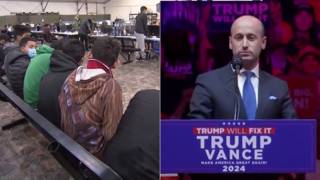
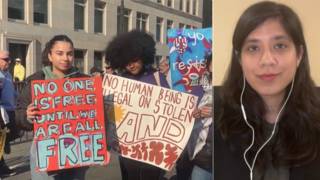
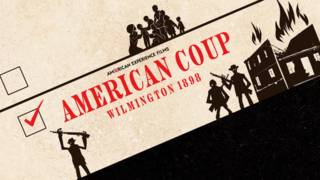






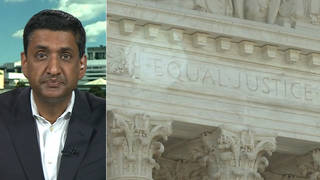
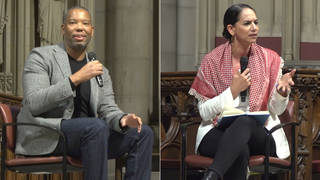
Media Options